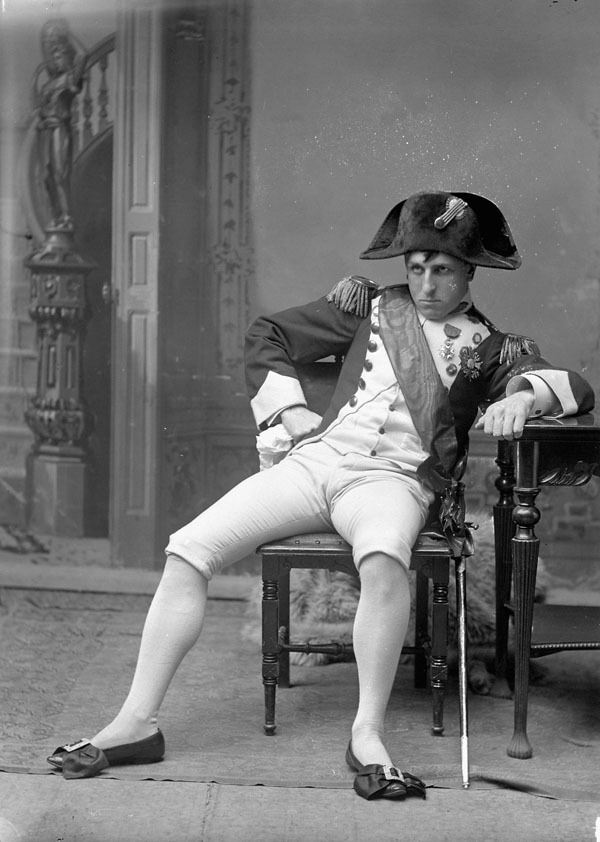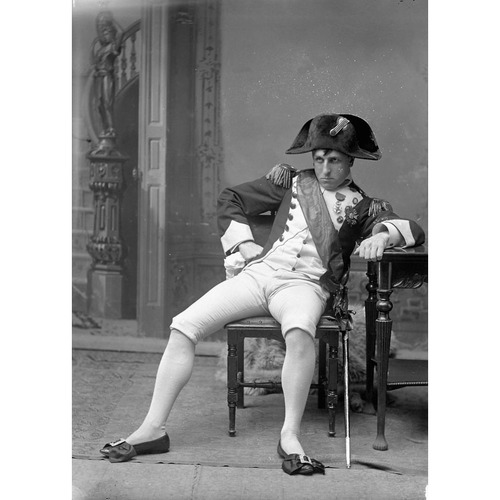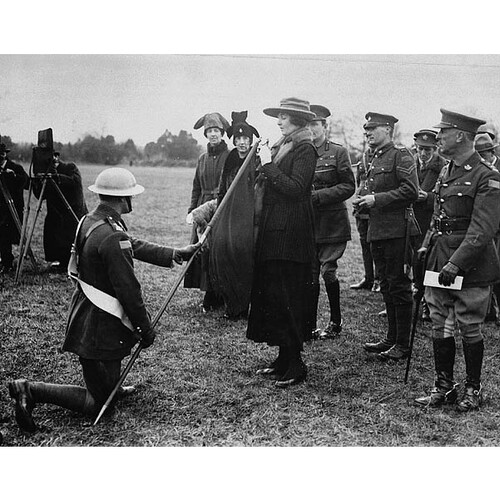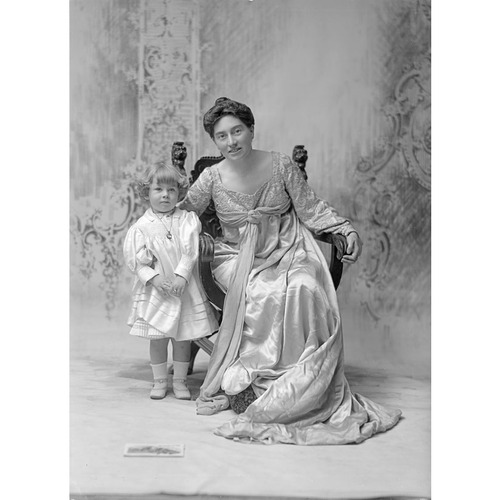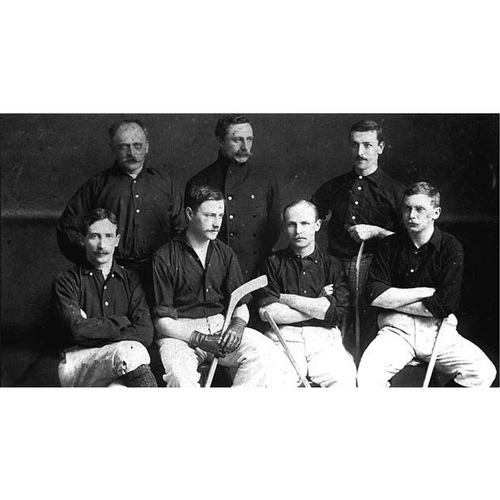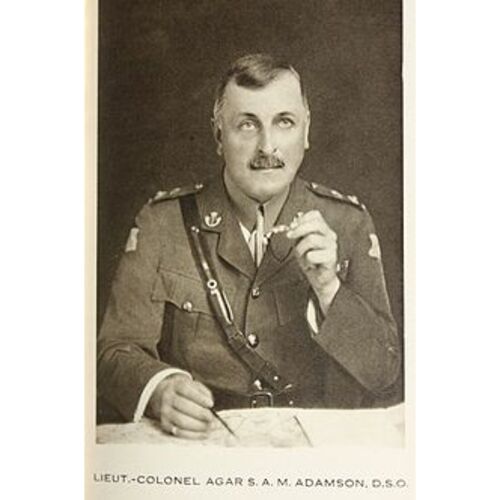ADAMSON, AGAR STEWART ALLAN MASTERTON, civil servant, militia and army officer, businessman, and bon vivant; b. 25 Dec. 1865 in Ottawa, second son of James Adamson and Mary Julia Derbishire; m. 15 Nov. 1899 Ann Mabel Cawthra* in Toronto, and they had two sons; d. 21 Nov. 1929 in London, England.
Without a war to fight, Agar Adamson would have lived out his days as an ageing Edwardian buck, memorable only for his charm and good looks. But the events of 1914 provided him with the opportunity to reinvent himself as a remarkable soldier. At 48, he was one of the oldest to enlist, and one of the first to go overseas. He survived nearly three years in the trenches, and became commanding officer of the legendary Princess Patricia’s Canadian Light Infantry. Adamson’s most remarkable memorial is the diary that he kept of his war, in the form of letters written daily to his wife. Unfailingly honest and direct, they are one of the best and most immediate personal Canadian accounts of World War I.
Adamson was born into the old Upper Canadian gentry; like many members of this class, he thought of himself as an overseas Englishman. His paternal grandfather, the Anglo-Irish sporting parson William Agar Adamson*, had immigrated in 1840 and became chaplain to Governor Lord Sydenham [Thomson*]. His maternal grandfather, Stewart Derbishire*, arrived in 1838 as a confidential agent in the service of Lord Durham [Lambton*] and later became an mla for Bytown. Agar grew up in post-confederation Ottawa, where his father was a clerk in the Senate. Thanks to a rich maternal uncle in England, he spent several years at Cambridge. Though he did not shine academically, and left without a degree, he was a great success as a horseman, winning the prestigious Newmarket stakes. He returned to Ottawa and on 4 Feb. 1890 joined his father on the staff of the Senate as a junior clerk; he held the same position when he left the civil service. He applied himself much more enthusiastically to becoming one of the capital’s most popular young bloods: he was gazetted a lieutenant in the No.1 Battalion of Infantry (Governor General’s Foot Guards) in 1893 and became a favourite at the slightly louche vice-regal court presided over by Lord Minto [Elliot*] and Lady Minto. In 1899 he married Mabel Cawthra, a talented and strong-minded Toronto heiress. Taking leave from the Senate, in March 1900 he was commissioned a lieutenant in Lord Strathcona’s Horse and set off for the war in South Africa.
Adamson’s experiences on the veld were transformational. He served with distinction, winning a mention in dispatches. He had a natural gift for command, and an innate respect for his men. “He wore a uniform rather as a priest wears vestments,” his younger son, Anthony, wrote in a family memoir. But a post-war attempt to become a regular officer in a British regiment proved unsuccessful, as did a plan to set up as a gentleman farmer. The Adamsons returned to Canada in 1903. Two years later Agar resigned from the Senate and moved to Toronto to become titular head of the Canadian branch, established by his wife, of the British decorating firm Thornton-Smith Company.
The outbreak of war on 4 Aug. 1914 found Adamson summering at Grove Farm in Port Credit, Ont., a property granted to the Cawthras in 1804. The following day he hastened to Ottawa. Though he was nearly blind in one eye, through connections at Rideau Hall he secured a commission as a captain in the newly formed Princess Patricia’s Canadian Light Infantry, financed by the Montreal millionaire Andrew Hamilton Gault*. Adamson arrived in England with the regiment in October.
His first letters from the front date from early 1915, the Patricias having entered the line as part of the 27th British Division. He was most struck by the pounding sound of artillery and the stench of putrefying human and animal flesh. “I counted seven dead horses just outside my trench yesterday,” he wrote on 3 March. “There is also a dead Frenchman there and has been for a long time. We got orders reading ‘Keep the Shelley Farm on your right, and pass between the broken tree and the dead Frenchman on your right’, so the poor fellow was being of some use in death.” Adamson’s most harrowing experience was recounted on 7 May, shortly before the PPCLI’s “Old Originals” were virtually wiped out, during the second battle of Ypres. “Enemy in front of us advancing their line of trenches and sniping force in every direction, fire from Maxims and artillery come from 3 different directions. . . . Two men have gone mad and have had to be disarmed. . . . It seems certain that this line cannot be held, and that we are only making a bluff at it.”
The line held and for his conspicuous bravery at Bellewaarde Ridge Adamson was awarded the Distinguished Service Order. After convalescing from a shoulder wound, he rejoined the Patricias in early 1916; a strong tactician, he was appointed commanding officer on 31 Oct. 1916 (somewhat to his discomfiture) and promoted lieutenant-colonel. “The isolation of a commanding officer is necessary,” he wrote to Mabel, “but most trying to one of my disposition.” Nevertheless, under him the regiment distinguished itself at both Vimy Ridge and Passchendaele, and in January 1918 it was singled out for its esprit de corps by Lieutenant-General Sir Arthur William Currie*, commander of the Canadian Corps.
In March 1918 Adamson turned over his command to Charles James Townshend Stewart* in order to be with his ailing wife, who had spent the war years in London and behind the lines in Belgium, working with civilian refugees. She recovered quickly but, sadly, Agar, who had been assigned to divisional headquarters, soon became one of war’s casualties. A delayed form of shell-shock, later known as post-traumatic stress syndrome, soured his judgement and his temperament. Soon after the armistice, his marriage disintegrated in all but name. He returned to Canada in March 1919; he spent much of the next decade visiting old friends in Ottawa and gambling in England.
In October 1929, having developed an interest in flying, he went up in an experimental airplane with a British aviator for a trip to Ireland. They crashed in the Irish Sea and although both survived, two hours in frigid water broke Adamson’s exceptional constitution. He died in London a few weeks later in the presence of his wife and son Anthony; with a panache Agar would have relished, Anthony carried his father’s ashes back to Canada in his own hatbox for a full-scale military funeral. He was buried at Trinity Anglican Church in Port Credit.
Among the many remembrances of Adamson, the ones he would have liked best were those of his military confrères. According to biographer Arthur Leonard Tunnell, “He was noted among his brother officers and friends as a most delightful dinner companion. He had a resonant voice, a good accent and an excellent vocabulary. His after-dinner speeches were not the less anticipated because he could indulge in pointed irony, and was not particular whose toes he trod on. . . . He refused to be bored.”
Adamson’s wartime correspondence has been published as Letters of Agar Adamson, 1914 to 1919: lieutenant colonel, Princess Patricia’s Canadian Light Infantry, ed. N. M. Christie (Nepean, Ont., 1997).
AO, RG 80-5-0-298, no.2602. LAC, MG 30, E149. Anthony Adamson, Wasps in the attic ([Toronto, 1987]). Can., Parl., Sessional papers, 1906, no.30: 196. Canadian men and women of the time (Morgan; 1912). Directory, Toronto, 1905–13. Sandra Gwyn, The private capital: ambition and love in the age of Macdonald and Laurier (Toronto, 1984); Tapestry of war: a private view of Canadians in the Great War (Toronto, 1992). Standard dict. of Canadian biog. (Roberts and Tunnell).
Cite This Article
Sandra Gwyn, “ADAMSON, AGAR STEWART ALLAN MASTERTON,” in Dictionary of Canadian Biography, vol. 15, University of Toronto/Université Laval, 2003–, accessed January 20, 2026, https://www.biographi.ca/en/bio/adamson_agar_stewart_allan_masterton_15E.html.
The citation above shows the format for footnotes and endnotes according to the Chicago manual of style (16th edition). Information to be used in other citation formats:
| Permalink: | https://www.biographi.ca/en/bio/adamson_agar_stewart_allan_masterton_15E.html |
| Author of Article: | Sandra Gwyn |
| Title of Article: | ADAMSON, AGAR STEWART ALLAN MASTERTON |
| Publication Name: | Dictionary of Canadian Biography, vol. 15 |
| Publisher: | University of Toronto/Université Laval |
| Year of publication: | 2005 |
| Year of revision: | 2005 |
| Access Date: | January 20, 2026 |


